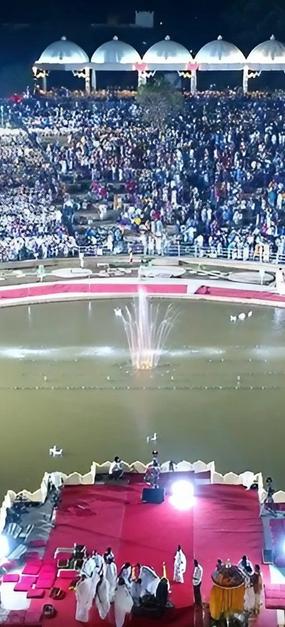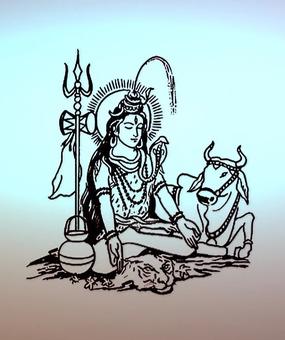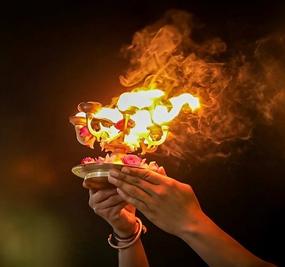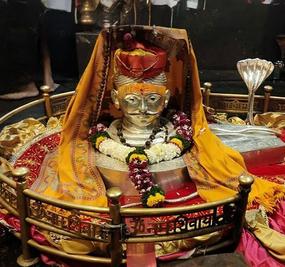Jyotirlingas are sacred shrines of Lord Shiva; it is believed that Lord Shiva himself visited these places and hence they have a special place in the hearts of devotees. There are 12 of them in India.
Jyotirlinga means ‘column or pillar of light’. The ‘stambha’ symbol represents that there is no beginning or end.
When Lord Brahma and Lord Vishnu had an argument about who was the supreme god, Lord Shiva appeared as a column of light and asked each one to find the ends. Neither could do it. It is believed that the places where these columns of light fell is where the jyotirlingas are located.
Nageshwar means ‘Lord of serpents’, so one who worships Nageshwar will have a poison-free mind and body. Lord Shiva also has a snake (Vasuki) around his neck.

Where is the Nageshwar Jyotirlinga located?
The Nageshwar Jyotirlinga is located in Daarukavanam between Gomti and Dwarka on the coast of Saurashtra in Gujarat, India.
History of Nageshwar Jyotirlinga
It is believed that Adi Shankaracharya laid the foundations of his Western Math at Kalika Peetha here.
Special features of Nageshwar Temple
There is a huge statue (25m) of Lord Shiva in a sitting position, a large garden and a pond in this temple. The linga is made of Dwaraka shila and has small chakras on it. It is in the shape of a tri-mukhi rudraksha (sacred beads representing Lord Shiva) and faces south, while the temple faces east.
What is the story behind Nageshwar Jyotirlinga?
The legend goes that there was once a demon called Daruk who lived in the forest along with his wife, Daruka. Because of a boon from Goddess Parvati, the demons had great powers which they abused to disturb festivities. They even captured and imprisoned a great devotee of Lord Shiva – a merchant named Supriya. Even in prison, Supriya continued his Shiva puja, wearing the holy rudraksha and chanting the Shiva mantra – Om Namah Shivaya. His devotion touched the Lord as he appeared before him, slayed the demon and saved him. The place where the demon was killed is called Daarukavanam. It is said that the Lord placed the Shiva Linga (called Naganath) there to establish his residence there.
It is also believed that Lord Krishna himself used to worship Lord Shiva here; he is said to have performed the rudrabhishekam here.
Interesting facts about Nageshwar Jyotirlinga
- It is believed that those who worship Nageshwar Jyotirlinga and meditate here will be freed from all poisons – both physical and spiritual (like anger and temptation) ones.
- There is some confusion about the actual site of the jyotirlinga. There are two other temples which have shrines for Nageshwar – Nagnath at Audhgram near Purna in Andhra Pradesh, and Jageshwar temple near Almora in Uttar Pradesh.
- There is an interesting story behind why the linga faces south. Legend has it that a devotee called Naamdev was asked by other devotees to step aside and not hide the Lord while chanting his name. Naamdev asked the others to suggest a direction where the Lord does not exist. The angry devotees carried him to the south and left him there. They were astonished to find that the linga was also facing south!
- People also worship Goddess Parvati along with Lord Shiva here.
While you can visit this spiritual spot at any time in the year, it would be best to visit it during the winter months – between September and March. Visiting this ancient and divine destination during Mahashivratri would be the ultimate treat for any devotee!
Read about other Jyotirlinga Temples
- 12 Jyotirlingas in India
- Trimbakeshwar Jyotirlinga
- Rameshwaram Jyotirlinga
- Kedarnath Jyotirlinga
- Grishneshwar Jyotirlinga
- Mahakaleshwar Jyotirlinga
- Mallikarjuna Jyotirlinga
- Bhimashankar Jyotirlinga
- Omkareshwar Jyotirlinga
- Nageshwar Jyotirlinga
- Somnath Jyotirlinga
- Baidyanath Jyotirlinga
- Vishwnath Jyotirlinga




















